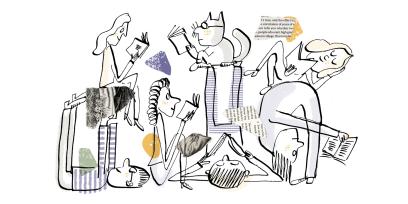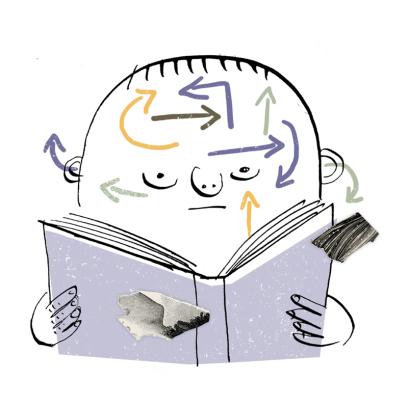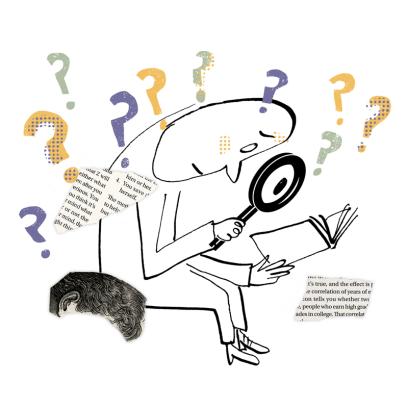It seems obvious why textbooks are hard to read. The material is dense; there’s a lot of information packed into relatively few words. Authors often feel obligated to give you a broad, complete understanding of a topic rather than to weave an interesting story from selected details. Teachers are ready to assign a textbook, even if it’s boring; it’s seen as a regrettable but unavoidable problem.
But there’s a more subtle reason that it’s hard to stay engaged when you read a textbook. To find out why, read this paragraph, one you might find in a typical high school textbook.
The Manhattan Project was the United States’ effort to produce a nuclear weapon, and it was the largest construction enterprise in the history of science. Because of its sensitive nature, a massive effort was made to keep the project secret. Famous scientists traveled under aliases; Enrico Fermi was known as Henry Farmer, for instance. And all telephone conversations at the test sites were monitored. Despite those efforts, historians agree that it probably would have been impossible to keep the secret if not for the fact that the project was of relatively small size.
Did you notice that the last sentence contradicted the first? Embedding a mistake or contradiction into a text and seeing whether readers notice it is a common research technique to measure comprehension. Readers are asked to judge each text on how well it’s written and explain their rating.
Readers are very likely to notice a word they don’t know. They are also very likely to notice if the grammar of a sentence is wrong. But they are much less likely to notice when two sentences contradict each other. Forty percent of high school students missed the contradiction in the paragraph above. To put it another way, if readers simply understand each sentence on its own, they figure they are doing what they’re supposed to do.
Coordinating meaning across sentences is crucial to reading comprehension, because sentences can take on quite different meanings depending on the surrounding context. For example, consider a simple sentence, “Maxim waved,” in different contexts:
Ann walked into the pizza parlor, looking for her friends. Maxim waved.
The boat slowly circled the wreckage, looking for survivors. Maxim waved.
“Oh, my God, that’s my husband!” Kate whispered. “Don’t do anything that would attract his attention!” Maxim waved.
In one way, the sentence always means the same thing (the physical act of waving by Maxim), but the more important meaning—why Maxim waved and the likely consequences of his action—is very different. It can be appreciated only if you interpret the sentence in light of what you’ve already read.
The same issue applies in a far more complex way to reading textbooks. Writers organize the material hierarchically, so readers often need to connect what they’re reading now to something they read a few pages ago. But readers expect a simple format. We first learn to read storybooks. Stories are easy to understand because the structure is simple and linear: A causes B, which causes C, and so on. Textbooks’ hierarchical format and content are more challenging, so you shouldn’t sit down to read a textbook and expect that the author will make your job easy. You need a different approach to reading such content.
When Reading to LearnWhat your brain will do: It will read the way you read for pleasure, because that’s familiar to you and it’s not obvious that it won’t work. You’ll read making minimal effort to coordinate ideas, trusting that the writer will make the connections explicit and easy to follow. How to outsmart your brain: Use specialized strategies for comprehension that fit both the kind of material you’re reading and the goals you have for reading it. |
Learning by reading is a substantial challenge, but with a few strategies under your belt, you can be much more successful in connecting the ideas as the author hoped you will. Here I share a couple of essential strategies; in a longer version of this article, I also share how to take notes while reading and tips for allocating enough time. Plus, I have a short guide for educators to help their students learn from challenging texts.
Use a Reading Strategy That Fits Your Goal
With a textbook or other difficult text, you can’t just start reading. You need to bring something to the process rather than wait for the author to intrigue you. At the same time, the advice “Read actively” is nearly useless. You may earnestly set the goal “I’m really going to think as I read, and I’m going to connect ideas,” but it’s just too easy for your attention to drift.
The solution is to set a concrete task to be completed as you read. The best known is called SQ3R, which has been around in various versions since the 1940s. SQ3R is an acronym for these steps:
Survey: Skim the reading, looking at the headings, subheadings, and figures. Get a rough idea of what it’s about. This is how you’ll determine, for example, that an article about the Human Genome Project is about its economic consequences, not the ethical implications of sequencing human DNA.
Question: Before you read, pose questions that you expect the reading to answer. Headings can be especially useful for this task; for example, if you see the heading “Marr’s Contribution to the Philosophy of Science,” the obvious question to ask is “What was Marr’s contribution to the philosophy of science?”
Read: Keeping in mind the rough idea of the article’s content you developed when you surveyed the reading, it’s time to actually read. And now you have a concrete task to be completed as you read: look for information that answers the questions you’ve posed.
Recite: When you’ve finished each section, recite what you’ve learned as if you were describing it to someone else. Summarize it and decide if it answers any of your questions.
Review: Reviewing is meant to be an ongoing process in which you revisit the content, focusing especially on the questions posed and the answers you derived.
Research confirms that using SQ3R improves comprehension, and it’s easy to see why. I’ve explained why you shouldn’t just plunge into a reading; if you first consider what it’s about and why you’re reading it, you will actually read it differently. The Survey and Question parts of SQ3R get you to do exactly that. I also emphasized that it’s essential to build meaning across sentences, and reading with the questions in mind also helps accomplish that.
The Recite step of SQ3R ought to help you pull your thoughts together and retain content, but even more, it’s a check of your comprehension. Remember that people can easily fool themselves into thinking they understand when they don’t. Reciting will help you better evaluate your comprehension.
The one drawback to the SQ3R method is that you may slip into “just reading” without thinking much. Here’s a trick that might help: after you’ve posed your questions (and before you start reading), place some blank Post-it notes in the text—maybe one at the end of each section. They’ll serve as visual reminders that you should stop, try to summarize the section you’ve just read, and think about whether the section answered any of the questions you posed.
SQ3R is useful, and it’s the best known of this sort of strategy, but there are others, including KWL (think about what you Know; what you Want to know; what you’ve Learned), SOAR (Set goals; Organize; Ask questions; Record your progress), and others. It’s no accident that most reading strategies have two important properties in common: they get you to think about your goal for reading before you start and connect the pieces of the reading by asking big-picture questions.
If these strategies seem like overkill, let me offer an alternative with just one step that may be an easy start to this kind of work. Instead of posing questions in advance, pose and try to answer questions as you’re reading, especially “Why?” questions in response to stated facts. For example, when you read, “The president can propose legislation, but a member of Congress must introduce it if it’s to become a bill,” you might ask, “Why must a member of Congress introduce it?” “Why?” questions tend to lead you to deeper principles and connections, in this case perhaps to the idea of the balance of powers among the three branches of the US government.
The advantage of this method is its flexibility—you don’t commit yourself to a set of questions before you’ve started reading. In addition, it’s easy to adapt this strategy to readings that tell you how to do something rather than telling you a bunch of facts. How-to information tends to occur in stages, so you can ask, “Why does this step come next?” The disadvantage of this method is that you can’t pose a question to yourself every time the author states a fact—that would slow you down too much—so effective question posing takes some practice.
Again, there’s no definitive evidence that one strategy is superior to another. What the evidence shows is that using a strategy is better than not using one.
|
In a sentence: Good reading strategies prompt you to think about the content and set concrete goals for what you’re to learn before you read, and help you connect ideas as you read. |
Daniel T. Willingham is a professor of cognitive psychology at the University of Virginia. He is the author of several books, including the bestseller Why Don’t Students Like School? This article is drawn with permission from his latest book, Outsmart Your Brain: Why Learning Is Hard and How You Can Make It Easy.
[illustrations: Serge Bloch]
 Member Benefits
Member Benefits Find Your Local
Find Your Local How to Join
How to Join En Espanol
En Espanol


